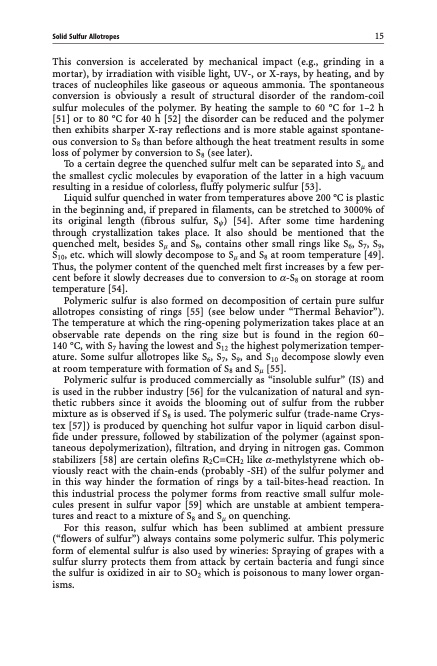
PDF Publication Title:
Text from PDF Page: 025
Solid Sulfur Allotropes 15 This conversion is accelerated by mechanical impact (e.g., grinding in a mortar), by irradiation with visible light, UV-, or X-rays, by heating, and by traces of nucleophiles like gaseous or aqueous ammonia. The spontaneous conversion is obviously a result of structural disorder of the random-coil sulfur molecules of the polymer. By heating the sample to 60 C for 1–2 h [51] or to 80 C for 40 h [52] the disorder can be reduced and the polymer then exhibits sharper X-ray reflections and is more stable against spontane- ous conversion to S8 than before although the heat treatment results in some loss of polymer by conversion to S8 (see later). To a certain degree the quenched sulfur melt can be separated into Sm and the smallest cyclic molecules by evaporation of the latter in a high vacuum resulting in a residue of colorless, fluffy polymeric sulfur [53]. Liquid sulfur quenched in water from temperatures above 200 C is plastic in the beginning and, if prepared in filaments, can be stretched to 3000% of its original length (fibrous sulfur, Sy) [54]. After some time hardening through crystallization takes place. It also should be mentioned that the quenched melt, besides Sm and S8, contains other small rings like S6, S7, S9, S10, etc. which will slowly decompose to Sm and S8 at room temperature [49]. Thus, the polymer content of the quenched melt first increases by a few per- cent before it slowly decreases due to conversion to a-S8 on storage at room temperature [54]. Polymeric sulfur is also formed on decomposition of certain pure sulfur allotropes consisting of rings [55] (see below under “Thermal Behavior”). The temperature at which the ring-opening polymerization takes place at an observable rate depends on the ring size but is found in the region 60– 140 C, with S7 having the lowest and S12 the highest polymerization temper- ature. Some sulfur allotropes like S6, S7, S9, and S10 decompose slowly even at room temperature with formation of S8 and Sm [55]. Polymeric sulfur is produced commercially as “insoluble sulfur” (IS) and is used in the rubber industry [56] for the vulcanization of natural and syn- thetic rubbers since it avoids the blooming out of sulfur from the rubber mixture as is observed if S8 is used. The polymeric sulfur (trade-name Crys- tex [57]) is produced by quenching hot sulfur vapor in liquid carbon disul- fide under pressure, followed by stabilization of the polymer (against spon- taneous depolymerization), filtration, and drying in nitrogen gas. Common stabilizers [58] are certain olefins R2C=CH2 like a-methylstyrene which ob- viously react with the chain-ends (probably -SH) of the sulfur polymer and in this way hinder the formation of rings by a tail-bites-head reaction. In this industrial process the polymer forms from reactive small sulfur mole- cules present in sulfur vapor [59] which are unstable at ambient tempera- tures and react to a mixture of S8 and Sm on quenching. For this reason, sulfur which has been sublimed at ambient pressure (“flowers of sulfur”) always contains some polymeric sulfur. This polymeric form of elemental sulfur is also used by wineries: Spraying of grapes with a sulfur slurry protects them from attack by certain bacteria and fungi since the sulfur is oxidized in air to SO2 which is poisonous to many lower organ- isms.PDF Image | Topics in Current Chemistry

PDF Search Title:
Topics in Current ChemistryOriginal File Name Searched:
Elemental-Sulfur-und-Sulfur-Rich-Compounds-I.pdfDIY PDF Search: Google It | Yahoo | Bing
Sulfur Deposition on Carbon Nanofibers using Supercritical CO2 Sulfur Deposition on Carbon Nanofibers using Supercritical CO2. Gamma sulfur also known as mother of pearl sulfur and nacreous sulfur... More Info
CO2 Organic Rankine Cycle Experimenter Platform The supercritical CO2 phase change system is both a heat pump and organic rankine cycle which can be used for those purposes and as a supercritical extractor for advanced subcritical and supercritical extraction technology. Uses include producing nanoparticles, precious metal CO2 extraction, lithium battery recycling, and other applications... More Info
| CONTACT TEL: 608-238-6001 Email: greg@infinityturbine.com | RSS | AMP |